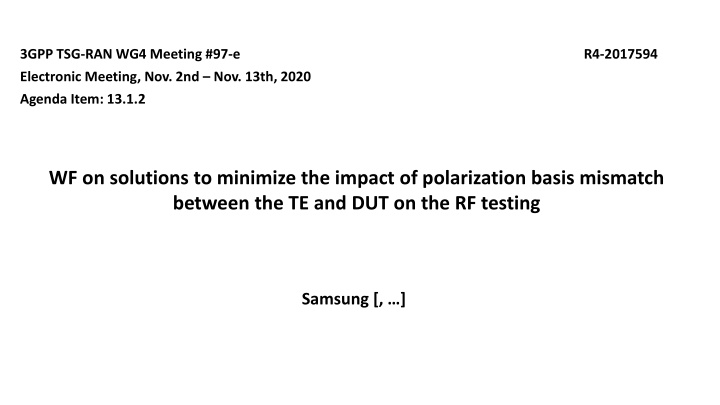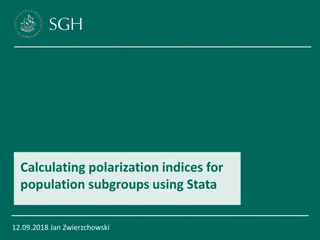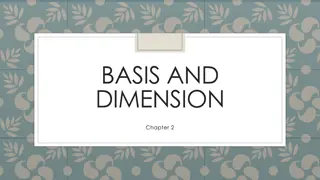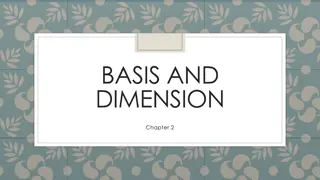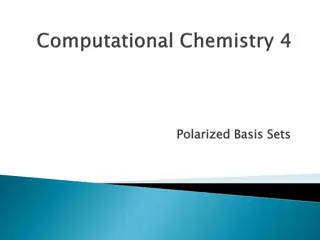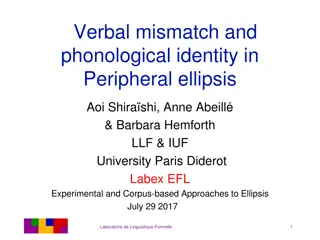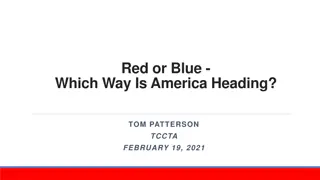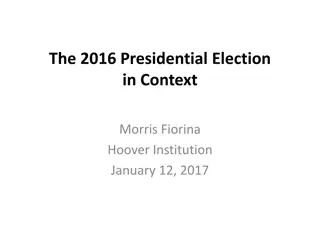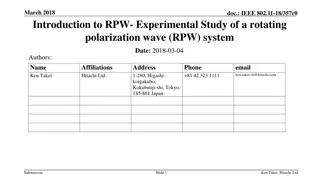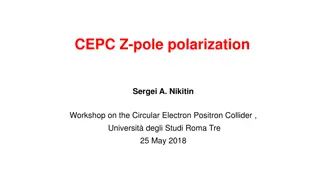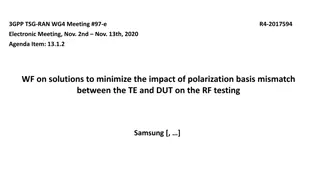Solutions to Minimize Polarization Basis Mismatch Impact in RF Testing
The agenda item discusses proposals to reduce the impact of polarization basis mismatch between the test equipment and device under test during RF testing in the 3GPP TSG-RAN-WG4 meeting. Various methods, such as the TPMI side condition method and DL polarization scan method, are being considered to enhance EIRP measurement for different UE types. Further refinement and investigation are ongoing to address these issues effectively.
Download Presentation

Please find below an Image/Link to download the presentation.
The content on the website is provided AS IS for your information and personal use only. It may not be sold, licensed, or shared on other websites without obtaining consent from the author.If you encounter any issues during the download, it is possible that the publisher has removed the file from their server.
You are allowed to download the files provided on this website for personal or commercial use, subject to the condition that they are used lawfully. All files are the property of their respective owners.
The content on the website is provided AS IS for your information and personal use only. It may not be sold, licensed, or shared on other websites without obtaining consent from the author.
E N D
Presentation Transcript
3GPP TSG-RAN WG4 Meeting #97-e Electronic Meeting, Nov. 2nd Nov. 13th, 2020 Agenda Item: 13.1.2 R4-2017594 WF on solutions to minimize the impact of polarization basis mismatch between the TE and DUT on the RF testing Samsung [, ]
Background EIRP measurement In RAN4#96e meeting, methods to enhance EIRP measurement were down selected (R4- 2012714) to 5 methods Focus on 3 methods which have been captured in WID (RP-201862) TPMI side condition method DL polarization scan method test mode to trigger TX diversity Check feasibility of 2 methods power up command to trigger TX diversity 2-port CSI-RS method UL demodulation In RAN4#96e meeting, dual polarization coherent receiver topology was agreed as a starting point In this meeting, above topics are further discussed in email thread 331 and GTW session.
WF1: EIRP measurement - TPMI side condition method Proposals Alt 2-1-1-1a: TPMI side condition method (option 1 in WF R4-2012714) to enhance UE EIRP measurement has been adopted by the standard, and the testability enhancement TPMI side condition method can be considered adopted Alt 2-1-1-1b: Alt 2-1-1-1a with further clarification that Practical TPMI shall be further applied for TPMI side condition method Alt 2-1-1-1c: Alt 2-1-1-1a only if clarification is provided whether RAN1 s definition of TPMI indices 2-5 forcing single-layer transmission using two antenna ports corresponds to the UE enabling two transmit chains at all times Alt 2-1-1-1d: Alt 2-1-1-1a only if chipset and OEM manufacturers can confirm whether Rel-15 nonCoherent UE s and Rel-16 nonCoherent without full power transmission mode1 (ul-FullPowerTransmission = fullpowerMode2 or fullpower) are still affected by this DL polarization mismatch issue. Alt 2-1-1-2: TPMI side condition method is only applicable for EIRP measurement for UL MIMO operation for partial UEs. Other methods to enhance EIRP measurement need to be investigated for non-MIMO cases in clause 6.2 of TS 38.101-2 Agreement TPMI side condition method is agreed as applicable method to enhance EIRP measurement for partial UEs This method can be applied for: - Rel-15 coherent UEs - Rel-16 coherent UEs - Rel-16 nonCoherent UEs which support uplink full power transmission - This method is not applied for Rel-15 nonCoherent UEs and Rel-16 nonCoherent UEs which do not support full power transmission TPMI side condition method shall be further refined under the umbrella of the hybrid methods in WF6.
WF2: EIRP measurement - DL polarization scan method Proposals Alt 2-1-5-1: DL pol. Scan is not valid (Anritsu, Qualcomm, Samsung, vivo, R&S, OPPO, Sony, Ericsson) (8) Alt 2-1-5-2: RAN4 to further consider the DL pol. Scan (LG, Keysight, Huawei, Apple) (4) Agreement Alt 2-1-5-1: The DL pol. scan method is not a valid method to enhance UE EIRP measurement The agreements are based on the assumption that the adopted hybrid test method(s) which described in WF 6 can ensure the test coverage for all UEs.
WF3: EIRP measurement - Test mode to trigger TX diversity Proposals Alt 2-1-3-1: remove test mode from list of candidate solutions (Qualcomm, Sony, Huawei, Ericsson, Apple) Alt 2-1-3-2: confirm test mode as a solution (Anritsu, Samsung, LG, Keysight) Alt 2-1-3-3: RAN4 should not go with test mode unless this is the only solution (vivo, R&S, OPPO) Agreement FFS if test mode to trigger TX diversity can be considered as a backup method under the umbrella of the hybrid methods in WF6
WF4: EIRP measurement power up command to trigger TX diversity Proposal Test enhancement for EIRP shall focus on the power command as it is the only command that the network can use to control the UE output power in the field The following companies expressed negative views on the feasibility of the proposal: Qualcomm, vivo, Keysight, OPPO, Huawei, Apple (6) The following companies expressed positive views on the feasibility of the proposal: Sony, Ericsson (2) Agreement The power up command to trigger TX diversity is not a valid method to enhance UE EIRP measurement The TPC power up command is not a method to enhance the UE EIRP measurement FFS if the TPC power command could trigger the Tx diversity.
WF5: EIRP measurement Configuration of 2-port CSI-RS Proposal 2-port CSI-RS shall be provided in EIRP test procedure; it can be provided simultaneously or sequentially Open issues Simultaneous vs. sequential configuration and whether sequential is feasible Mapping between ports and polarizations in the test equipment and whether this is feasible for test equipment Applicability to Rel-16 beam correspondence capabilities Whether phase coherency between ports at the test equipment side is needed Whether this configuration can actually help to trigger TX diversity behavior at the UE Agreement further discuss 2-port CSI-RS method under the umbrella of the hybrid methods in WF6 if above issues could be addressed
WF6: EIRP measurement hybrid methods Proposal select the method based on manufacturer declaration: a. If UE declares codebookSubset = fullyAndPartialAndNonCoherent, TPMI index is set to [2]. This is applicable to UE s from Rel.15 onwards. b. If UE declares codebookSubset = nonCoherent and ul-FullPowerTransmission-r16 = fullpowerMode1, TPMI index is set to [2]. This is applicable to UE s from Rel.16 onwards. c. Otherwise, an alternate method TBC is to be used (e.g. 2-port CSI-RS, test mode or other). Agreement Different approaches can be adopted based on UE capability, detailed applicability rule can be further discussed TPMI side condition test method is agreed to be introduced FFS whether additional test methods need to be introduced (e.g. 2-port CSI-RS, test mode). Whether an alternate method needs to be introduced and, if agreed it is needed, what it can be is FFS and is a secondary priority task within the objective TPMI method is applicable for EIRP measurement test cases for 1 layer transmission with 2 SRS ports configured.
WF7: UL demodulation Proposal It is proposed to confirm the dual polarization coherent receivers measurement setup as the enhancement which addresses the UE demodulation part of the polarization mismatch objective Agreement RAN4 confirms the dual polarization coherent receivers measurement setup as the enhancement which addresses the UE demodulation part of the polarization mismatch objective
Reference 1. R4-2014266, FR2 testability enhancement for polarization mismatch, Qualcomm 2. R4-2014275, Discussion on FR2 EIRP measurement enhancement, 3. R4-2014827, Analysis on practical TPMI and 2-port CSI-RS for EIRP measurement, MediaTek 4. R4-2014920, Views on polarization mismatch, Apple 5. R4-2015871, Views on testability enhancement for UE FR2 test, Sony, Ericsson 6. R4-2016212, On minimizing the impact of polarization basis mismatch between the TE and DUT, Keysight 7. R4-2016568, Views on polarization basis mismatch, Rohde & Schwarz 8. R4-2017429, Email discussion summary for [97e][331] FR2_enhTestMethods, Moderator(Apple)
